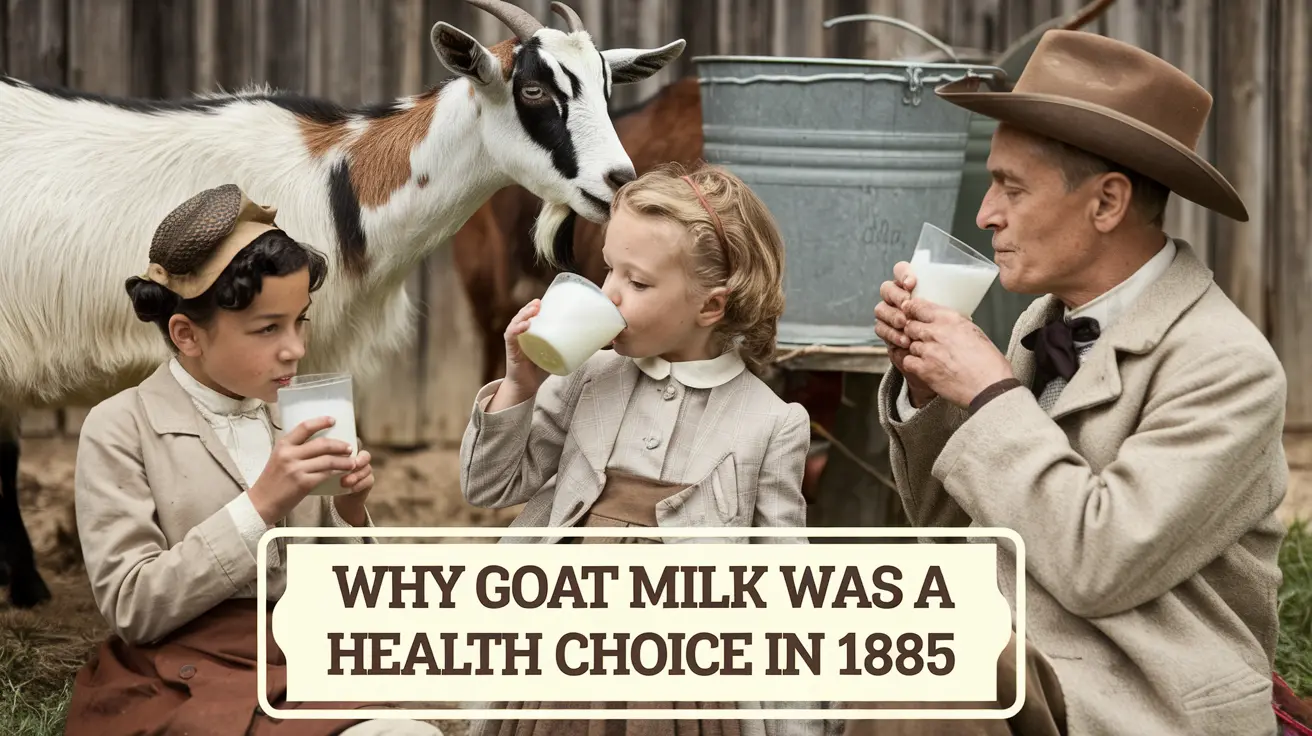
Why Goat Milk Was a Health Choice in 1885
In 1885, goat milk became a popular health choice due to its unique nutritional properties and accessibility. It was used both as a staple in rural communities and as a health tonic in urban areas. Unlike cow milk, which was harder to obtain in some regions, goat milk offered various health benefits that made it a preferred option for many. This article explores why goat milk gained popularity in 1885 and the reasons it became a trusted source of nutrition and health.
1. Easier Digestibility
One of the main reasons goat milk was favored in 1885 was its easy digestibility. Goat milk contains smaller fat globules and less lactose than cow milk, which makes it easier for people to digest. Many people who experienced stomach discomfort or intolerance with cow milk found that they could consume goat milk without any issues. This was especially beneficial for infants and elderly individuals, who often struggled with digestion problems.
Key Benefits of Digestibility:
- Less lactose: Goat milk has less lactose, making it more tolerable for those with lactose sensitivity.
- Smaller fat globules: These help in quicker digestion, reducing the chances of bloating or indigestion.
2. Rich Nutritional Content
Goat milk was known for its high nutritional content, which made it a valuable addition to the diet in 1885. It contains essential vitamins, minerals, and proteins that support overall health. In fact, goat milk is a good source of calcium, potassium, and magnesium, which contribute to stronger bones, better heart health, and balanced muscle function.
Nutrients in Goat Milk:
- Calcium: Promotes strong bones and teeth.
- Potassium: Helps regulate blood pressure.
- Magnesium: Aids in muscle and nerve function.
These nutrients were important at a time when many people had limited access to diverse food sources, and goat milk offered a concentrated source of these essential elements.
3. Natural Immunity Booster
Goat milk was often seen as a natural way to boost immunity. This was due to its high levels of vitamins A and C, which play a critical role in supporting the immune system. In 1885, when modern medical treatments were not as advanced, people relied on natural foods to strengthen their immune systems, and goat milk became a key part of this effort.
Immune-Boosting Properties:
- Vitamin A: Supports the immune system by protecting against infections.
- Vitamin C: Helps in the production of white blood cells, which fight infections.
By consuming goat milk regularly, many people believed they could reduce their chances of falling ill and enhance their body’s ability to fight infections.
4. Accessible to Rural Communities
In 1885, many people lived in rural areas where large-scale dairy farms were not yet common. Goat milk was a practical choice because goats are easier to raise and maintain compared to cows. Goats require less space, can thrive on different types of vegetation, and are more resilient in harsh conditions.
For rural families, owning goats was a way to ensure a consistent supply of milk. The ability to produce their own food and milk provided both nutritional security and economic benefit. Many households relied on goats for milk because they could produce enough for family consumption without requiring significant investment in land or resources.
5. Less Risk of Disease Transmission
In the late 19th century, foodborne illnesses and diseases spread through contaminated milk were a major concern. Cow milk, especially when produced in unsanitary conditions, was known to carry diseases like tuberculosis and brucellosis. Goat milk, on the other hand, was believed to carry a lower risk of transmitting such diseases, especially when sourced from well-maintained animals.
This perception of goat milk being safer added to its appeal in 1885, particularly for families who were cautious about the health risks associated with dairy consumption.
6. Used in Infant Nutrition
Goat milk was frequently recommended for infants who could not tolerate cow milk. At a time when commercial baby formulas did not exist, mothers often turned to goat milk as a safer alternative for babies who had digestive issues with cow milk. Goat milk’s gentle composition and nutrient profile made it a preferred option for feeding infants, particularly those who were unable to be breastfed.
Benefits for Infants:
- High protein content: Supports growth and development.
- Easily digestible: Helps reduce colic and digestive distress in infants.
Many doctors and health practitioners of the time advised goat milk as a suitable substitute for mothers who needed an alternative for infant nutrition.
7. Goat Milk as a Remedy for Ailments
In 1885, people believed that goat milk could treat a variety of health conditions. It was used as a natural remedy for digestive issues, skin conditions, and respiratory problems. Some people also believed that goat milk could help cure tuberculosis, a serious illness at the time. While modern science has since debunked some of these claims, the belief in goat milk’s healing powers contributed to its popularity in the late 19th century.
Ailments Treated with Goat Milk:
- Digestive issues: Used to relieve symptoms of indigestion and ulcers.
- Skin conditions: Applied to treat eczema and other skin irritations.
- Respiratory problems: Consumed to alleviate symptoms of asthma and bronchitis.
People in 1885 trusted goat milk not only as a nutritious drink but also as a therapeutic aid for improving overall health and well-being.
8. Sustainable and Cost-Effective
Raising goats was a more sustainable and cost-effective option compared to cows. Goats can live on less land, consume less water, and eat a wider variety of plants. In 1885, sustainability was crucial for families who needed to make the most of their resources. Goats provided milk, meat, and even wool, making them a valuable asset for many households.
The versatility of goats and their minimal maintenance costs made them an economical choice for producing milk. For families in rural or lower-income areas, goat milk became a staple because it required fewer resources while still offering essential nutrients.
9. Cultural Importance of Goat Milk
In 1885, goat milk held cultural significance in various regions of the world. In countries like Greece, Turkey, and Italy, goat milk was a traditional food that had been consumed for centuries. People passed down goat-raising practices through generations, and goat milk became a symbol of health, strength, and longevity.
The cultural importance of goat milk also influenced its popularity in the United States and other parts of the world during this time. Immigrant communities brought their traditions with them, and goat milk became a part of the culinary and health landscape in their new homes.
10. The Influence of Folk Medicine
Folk medicine played a major role in 1885, especially in rural areas where access to doctors was limited. Goat milk was often recommended by local healers and practitioners as a remedy for various ailments. People trusted the wisdom of folk medicine, which praised goat milk for its ability to heal the body and maintain vitality.
Folk Remedies Using Goat Milk:
- Goat milk poultices: Used to treat skin infections and wounds.
- Goat milk baths: Believed to improve skin conditions and promote healing.
These traditional uses of goat milk reinforced its reputation as a health-promoting drink in the late 19th century.
11. Endorsements from Health Practitioners
By 1885, several health practitioners and early nutritionists began to recognize the benefits of goat milk. They promoted it as a nutritious and healthy alternative to cow milk, especially for those with digestion problems. These endorsements helped goat milk gain wider acceptance beyond rural communities.
Practitioners’ Recommendations:
- Promoted for sensitive stomachs: Early nutritionists noted that goat milk was gentler on the digestive system.
- Endorsed for skin health: Some health practitioners recommended goat milk for improving skin conditions due to its rich vitamin content.
These endorsements from medical professionals helped to solidify goat milk’s status as a health choice for a wider audience.
12. The Transition to Modern Dairy Practices
As the dairy industry grew and became more industrialized, the focus shifted toward cow milk due to its higher production volumes. However, goat milk maintained its niche following, especially among those who valued its unique health benefits. The qualities that made goat milk popular in 1885—digestibility, nutrition, and accessibility—continue to attract people to this day.
Conclusion
Goat milk was a health choice in 1885 due to its easier digestibility, rich nutritional content, immune-boosting properties, and cultural significance. It was accessible, sustainable, and favored for treating ailments and promoting well-being. While the dairy industry has evolved since then, the reasons people valued goat milk in the 19th century remain relevant today. The qualities that made goat milk a trusted source of nutrition in 1885 continue to benefit those who seek its unique health advantages in modern times.



